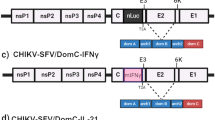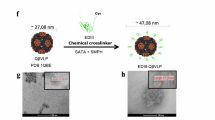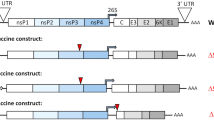Abstract
Chikungunya virus (CHIKV) has infected millions of people in Africa, Europe and Asia1,2 since this alphavirus reemerged from Kenya in 2004. The severity of the disease and the spread of this epidemic virus present a serious public health threat in the absence of vaccines or antiviral therapies. Here, we describe a new vaccine that protects against CHIKV infection of nonhuman primates. We show that selective expression of viral structural proteins gives rise to virus-like particles (VLPs) in vitro that resemble replication-competent alphaviruses. Immunization with these VLPs elicited neutralizing antibodies against envelope proteins from alternative CHIKV strains. Monkeys immunized with VLPs produced high-titer neutralizing antibodies that protected against viremia after high-dose challenge. We transferred these antibodies into immunodeficient mice, where they protected against subsequent lethal CHIKV challenge, indicating a humoral mechanism of protection. Immunization with alphavirus VLP vaccines represents a strategy to contain the spread of CHIKV and related pathogenic viruses in humans.
This is a preview of subscription content, access via your institution
Access options
Subscribe to this journal
Receive 12 print issues and online access
$259.00 per year
only $21.58 per issue
Buy this article
- Purchase on SpringerLink
- Instant access to full article PDF
Prices may be subject to local taxes which are calculated during checkout




Similar content being viewed by others
References
Simon, F., Savini, H. & Parola, P. Chikungunya: a paradigm of emergence and globalization of vector-borne diseases. Med. Clin. North Am. 92, 1323–1343 (2008).
Powers, A.M. & Logue, C.H. Changing patterns of Chikungunya virus: re-emergence of a zoonotic arbovirus. J. Gen. Virol. 88, 2363–2377 (2007).
Ross, R.W. The Newala epidemic. III. The virus: isolation, pathogenic properties and relationship to the epidemic. J. Hyg. (Lond.) 54, 177–191 (1956).
Staples, J.E., Breiman, R.F. & Powers, A.M. Chikungunya fever: an epidemiological review of a re-emerging infectious disease. Clin. Infect. Dis. 49, 942–948 (2009).
Tsetsarkin, K.A., Vanlandingham, D.L., McGee, C.E. & Higgs, S. A single mutation in Chikungunya virus affects vector specificity and epidemic potential. PLoS Pathog. 3, e201 (2007).
Enserink, M. Entomology. A mosquito goes global. Science 320, 864–866 (2008).
Strauss, J.H. & Strauss, E.G. The alphaviruses: gene expression, replication and evolution. Microbiol. Rev. 58, 491–562 (1994).
Cheng, R.H. et al. Nucleocapsid and glycoprotein organization in an enveloped virus. Cell 80, 621–630 (1995).
Zhang, W. et al. Placement of the structural proteins in Sindbis virus. J. Virol. 76, 11645–11658 (2002).
Arankalle, V.A. et al. Genetic divergence of Chikungunya viruses in India (1963–2006) with special reference to the 2005–2006 explosive epidemic. J. Gen. Virol. 88, 1967–1976 (2007).
Harrison, V.R., Binn, L.N. & Randall, R. Comparative immunogenicities of chikungunya vaccines prepared in avian and mammalian tissues. Am. J. Trop. Med. Hyg. 16, 786–791 (1967).
Naldini, L., Blomer, U., Gage, F.H., Trono, D. & Verma, I.M. Efficient transfer, integration, and sustained long-term expression of the transgene in adult rat brains injected with a lentiviral vector. Proc. Natl. Acad. Sci. USA 93, 11382–11388 (1996).
Yang, Z.-Y. et al. pH-dependent entry of severe acute respiratory syndrome coronavirus is mediated by the Spike glycoprotein and enhanced by dendritic cell transfer through DC-SIGN. J. Virol. 78, 5642–5650 (2004).
Yang, Z.-Y. et al. Immunization by avian H5 influenza hemagglutinin mutants with altered receptor binding specificity. Science 317, 825–828 (2007).
Sourisseau, M. et al. Characterization of reemerging Chikungunya virus. PLoS Pathog. 3, e89 (2007).
McClure, M.O., Sommerfelt, M.A., Marsh, M. & Weiss, R.A. The pH independence of mammalian retrovirus infection. J. Gen. Virol. 71, 767–773 (1990).
Eckels, K.H., Harrison, V.R. & Hetrick, F.M. Chikungunya virus vaccine prepared by Tween-ether extraction. Appl. Microbiol. 19, 321–325 (1970).
Pletnev, S.V. et al. Locations of carbohydrate sites on alphavirus glycoproteins show that E1 forms an icosahedral scaffold. Cell 105, 127–136 (2001).
Caspar, D.L. & Klug, A., Physical principles in the construction of regular viruses. Cold Spring Harb. Symp. Quant. Biol. 27, 1–24 (1962).
Couderc, T. et al. A mouse model for Chikungunya: young age and inefficient type-I interferon signaling are risk factors for severe disease. PLoS Pathog. 4, e29 (2008).
Couderc, T. et al. Prophylaxis and therapy for Chikungunya virus infection. J. Infect. Dis. 200, 516–523 (2009).
Levitt, N.H. et al. Development of an attenuated strain of chikungunya virus for use in vaccine production. Vaccine 4, 157–162 (1986).
McClain, D.J. et al. Immunologic interference from sequential administration of live attenuated alphavirus vaccines. J. Infect. Dis. 177, 634–641 (1998).
Edelman, R. et al. Phase II safety and immunogenicity study of live Chikungunya virus vaccine TSI-GSD-218. Am. J. Trop. Med. Hyg. 62, 681–685 (2000).
Harrison, V.R., Eckels, K.H., Bartelloni, P.J. & Hampton, C. Production and evaluation of a formalin-killed Chikungunya vaccine. J. Immunol. 107, 643–647 (1971).
Tiwari, M. et al. Assessment of immunogenic potential of Vero adapted formalin inactivated vaccine derived from novel ECSA genotype of Chikungunya virus. Vaccine 27, 2513–2522 (2009).
Wang, E. et al. Chimeric alphavirus vaccine candidates for Chikungunya. Vaccine 26, 5030–5039 (2008).
Muthumani, K. et al. Immunogenicity of novel consensus-based DNA vaccines against Chikungunya virus. Vaccine 26, 5128–5134 (2008).
Chackerian, B. Virus-like particles: flexible platforms for vaccine development. Expert Rev. Vaccines 6, 381–390 (2007).
Bachmann, M.F. et al. The influence of antigen organization on B cell responsiveness. Science 262, 1448–1451 (1993).
Noad, R. & Roy, P. Virus-like particles as immunogens. Trends Microbiol. 11, 438–444 (2003).
Ludwig, C. & Wagner, R. Virus-like particles-universal molecular toolboxes. Curr. Opin. Biotechnol. 18, 537–545 (2007).
Akahata, W., Yang, Z.Y. & Nabel, G.J. Comparative immunogenicity of human immunodeficiency virus particles and corresponding polypeptides in a DNA vaccine. J. Virol. 79, 626–631 (2005).
Tang, G. et al. EMAN2: an extensible image processing suite for electron microscopy. J. Struct. Biol. 157, 38–46 (2007).
Ludtke, S.J., Baldwin, P.R. & Chiu, W. EMAN: semiautomated software for high-resolution single-particle reconstructions. J. Struct. Biol. 128, 82–97 (1999).
Acknowledgements
We thank K. Nagashima for help with electron microscopy and J.D. Yoder for initiating cryoelectron microscopy reconstruction. We also thank A. Tislerics and J. Stein for help with manuscript preparation, B. Hartman for graphic arts and members of the Nabel lab for helpful discussions. We thank R. Seder and D.D. Pinschewer (Department of Pathology and Immunology, University of Geneva) for their kind gift of Ifnar1−/− mice, A. Ault, J.-P. Todd, A. Zajac, C. Chiedi (Vaccine Research Center) and D. Gordon (Bioqual) for plaque assay and processed animal blood samples, J. Greenhouse for RT-PCR assay, B.W. Finneyfrock, T. Jenkins and A. Dodson for animal sampling and care, K. Foulds, M. Donaldson and M. Roederer for monkey sample procedures and J. Lee for preparing 293F cells for VLP production. This research was supported by the Intramural Research Program of the Vaccine Research Center, National Institute of Allergy and Infectious Diseases, US National Institutes of Health.
Author information
Authors and Affiliations
Contributions
W.A., Z.-Y.Y., S.H., S.R. and G.J.N. designed the research studies; W.A., Z.-Y.Y., H.A., S.S., H.A.H., W.-P.K., M.G.L. and S.R. performed the research; W.A. and Z.-Y.Y. contributed to development and generation of vectors; and W.A., Z.-Y.Y., H.A., S.S., H.A.H., W.-P.K., M.G.L., S.H., M.G.R., S.R. and G.J.N. analyzed data; and W.A., Z.-Y.Y., S.H., M.G.R., S.R. and G.J.N. wrote the paper.
Corresponding author
Ethics declarations
Competing interests
The authors declare no competing financial interests.
Supplementary information
Supplementary Text and Figures
Supplementary Methods and Supplementary Figures 1–3 (PDF 852 kb)
Rights and permissions
About this article
Cite this article
Akahata, W., Yang, ZY., Andersen, H. et al. A virus-like particle vaccine for epidemic Chikungunya virus protects nonhuman primates against infection. Nat Med 16, 334–338 (2010). https://doi.org/10.1038/nm.2105
Received:
Accepted:
Published:
Issue date:
DOI: https://doi.org/10.1038/nm.2105
This article is cited by
-
Strategic considerations on developing a CHIKV vaccine and ensuring equitable access for countries in need
npj Vaccines (2023)
-
Chikungunya fever
Nature Reviews Disease Primers (2023)
-
A molecular understanding of alphavirus entry and antibody protection
Nature Reviews Microbiology (2023)
-
Innate immune response in patients with acute Chikungunya disease
Medical Microbiology and Immunology (2023)
-
New Vaccines on the Immediate Horizon for Travelers: Chikungunya and Dengue Vaccines
Current Infectious Disease Reports (2023)



